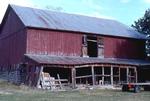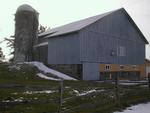News & Events
Notes from the Field Station: Our History: Field Station's Past, Present, and Future
Posted on Monday, August 1, 2011
Thirty-one years ago the Field Station was born, brought into existence by Westminster College's Board of Trustees. What actually happened is that in 1980 the Trustees approved a plan by the Department of Biology to gain custodianship for a 10-year period of the 50-acre "Offutt farm" that the College bought in 1964 but had not used in any significant way.
The plan as approved had been hammered out by faculty in the department who envisioned a study and research area-an outdoor laboratory-that would allow and encourage faculty and students to carry out experiments and other studies in the outdoors equal to what they might do in a traditional lab with benches and other standard tools of biology. Ten years was judged by the Trustees as an adequate stretch of time to see how seriously the faculty took hold of the expanded opportunity for their interests in environmental-related science.
Almost simultaneous with the acquisition of the Field Station property, the Environmental Science major at Westminster was approved. In both of these newly-developed ventures Westminster became a front-runner among private colleges of our region. At the end of 10 years the Trustees approved the extension of the "lease" for the Department of Biology to continue operating the Field Station.
Now would be a good time to review what has been accomplished and ask whether the Field Station meets the needs of Westminster College and the regional community?
The first 12 years were beset with challenges, most of which related to time and money. Budgets were tight and no grants, major gifts or bequests had yet come in for operation and expansion. Work by faculty at the Field Station, except for summers, had to be done in addition to full-time teaching. The College anteed up funds from the operating budget in 1983 to construct a 50-foot footbridge across the Little Neshannock Creek that then provided access by classes to the "bio farm," as it had colloquially been called. This access was tenuous, limited to the times when passage through a wetland was feasible (that is, when it wasn't over-the-boots soggy).
Eleven years after the footbridge was constructed, a boardwalk (beginning at the bridge and continuing eastward in yearly installments) added several weeks to the times when walking out from the main campus was possible. The Nature Trail was named to honor alumna and former faculty member, Lucile Beerbower Frey '42, in 1995. The boardwalk trail wasn't finished until 1998 due to the small window of accessibility of the wetland to tractors and equipment during summer work periods.
Slowly the 50 acres gained accessibility and later another five acres were added to the boundaries of the Field Station on the west side of the creek. The old barn on the property was renovated into a Nature Center beginning in 1994 with a grant from the 1525 Foundation and completed in 2003 through the generosity of two alumnae (Jean Van Vranken Reichmann '42 and Lucile Beerbower Frey) who included the Field Station in the settlement of their respective estates. A Microforest for native species was established and named to honor two other generous alumni (William '36 and Virginia Rye '42 Offutt). In 2005 a major composting project was funded by the Department of Environmental Protection of the Commonwealth of Pennsylvania for College and community to recycle organic wastes. This project ended after four years, having received for composting over 450 tons of feedstocks.
In its current usage, the Field Station is the site for College classes in biology, environmental science, chemistry, art and literature. In 2010-2011 at least 400 students in these classes came here for one or more sessions. Student research projects are currently underway. Several campus clubs held meetings and walked out for volunteer work. Alumni came to visit and often, during or after the visit, sent money to plant trees or add solar panels.
More than 300 high school, elementary and pre-school students had field days here. Boy Scouts and Girl Scouts have met. Two Eagle Scout service projects had their focus at the Field Station. Bear Tree Connections, a local environmental club for children, has its home base in the Nature Center year round. A community garden, especially for children, was established this past year. Loops were added to the Nature Trail that now has well over two miles of paths. Community service clubs and church groups have come, often to walk the Labyrinth, a unique meditation spot that was built by College and community in 2006 as a memorial to Sandy Edmiston ‘05. Once a year Westminster's Vesper Service is held at the Labyrinth. Unnumbered community folk visit the Labyrinth or walk the Frey Nature Trail, both open all year. Our solar panels connect to the electric grid of our region. Beginning six months ago, data from the Travis Weather Station are communicated on the World Wide Web.
For those interested, the Field Station is now set up for geocaching and the social network, Facebook. Friends are sought to connect.
Looking back 31 years, we ask if the Field Station has justified its existence and reached its maximum potential. Have we plateaued? Should the current staff be increased? Only the faint of heart would conclude that there are no new further challenges to be faced, no continued explorations of nature deserving attention or college/community services to be rendered.
What of continuing substance have we really achieved for College and community? What yet is there to do? All of these questions beg for answers that I hope will come from interested and concerned students, alumni and community members. Let us know the answers. An email/phone message or a letter could help plot the future of Westminster's Field Station. This is a serious request for a response.
Clarence Harms, Director of the Field Station
Box 116 Westminster College
724-946-6001
harmsc@westminster.edu



More Stories



